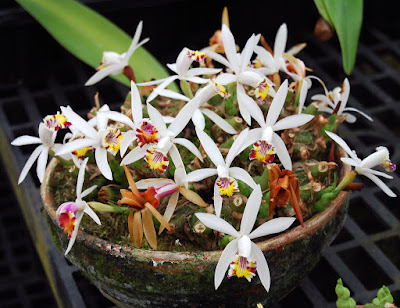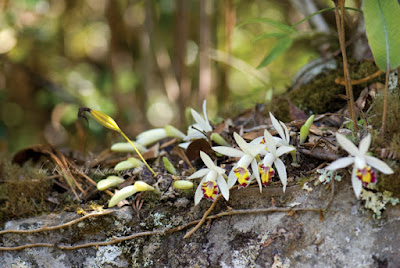Pleione maculata is found in Yunnan (China), Burma and Thailand; some populations are also found in India (the state of Assam), Nepal, Laos and Vietnam. Its natural habitat is the mountain areas at an altitude of 600-1700 meters...
Pleione maculata also called as The Spotted Pleione, Coelogyne arthuriana, Coelogyne diphylla, Coelogyne maculata, Coelogyne maculata var. virginea, Gomphostylis candida, Pleione autumnalis, Pleione diphylla, Pleione maculata var. arthuriana, Pleione maculata var. virginea, is a species of the genus Pleione. This species was described by John Lindley & Joseph Paxton in 1851.
IDENTIFY PLEIONE MACULATA
Pleione maculata is found in Yunnan (China), Burma and Thailand; some populations are also found in India (the state of Assam), Nepal, Laos and Vietnam. Its natural habitat is the mountain areas at an altitude of 600-1700 meters.
It is a small sized, cool to cold growing terrestrial with barrel-shaped, apically conical, green spotted with purple, up to 3.5 cm long pseudobulbs carrying in apical pairs on mature pseudobulbs, elliptic-lanceolate to oblanceolate, acute, plicate, 20-25 cm long leaves.
The Spotted Pleione blooms on a very short, to 2 flowered inflorescence with large inflated, truncate floral bracts arising in the fall before the leaves with fragrant flowers. The flowers are 4-6 cm in diameter and have a slight scent of apple.
PLEIONE MACULATA CARE AND CULTURE
Cultural information should only be used as a guide, and should be to be adapted to suit you. Your physical location; where you grow your plants, how much time you have to devote to their care, and many other factors, will need to be taken into account. Only then can you decide on the cultural methods that best suit you and your plants.
Light:
Pleione maculata needs a light level of 24000-30000 lux, but the direct sun is to be shielded. During the resting phase, strong light is not essential, but in February we need to make sure that the pseudobulbs get enough light to start producing the growths.
Temperature:
The ideal temperatures during the growing period are 22-24 ° C during the day and 15-18 ° C at night, while the temperatures in the resting phase must be between 5 ° C and 10 ° C.
Humidity:
The Spotted Pleione comes from very humid environments and needs at least 70% humidity (ideal 80-90%).
Substrate, growing media and repotting:
Pleione maculata is to be cultivated exclusively in pots. The sphagnum mixed with perlite (in the proportion 1: 1), or a mixture of small bark (0.5-1 cm) and minced sphagnum (in the proportion 3: 2) can be used as a substrate. It is not essential to choose a transparent vase, but I prefer it because it helps me to check the conditions of the substrate and roots, and also to regulate with the watering.
Watering:
This species get water abundantly and regularly; the substrate must never become dry. Particular care should be taken to keep it always moist, especially when temperatures are high. When the orchid is at rest, the substrate is only slightly moist, vaporizing it slightly once a week.
Fertilizer:
This orchid is fertilized only during the growth phase. Use 1/4 of the indicated dose on the bottle of a special liquid fertilizer for orchids 1 time every 14 days. Before fertilizing the orchid you have to water it, to avoid the harmful contact of the fertilizer with the dry roots.
Rest period:
In winter, Pleione maculata needs less water, but they can not stay dry for long period. Fertilization should stopped until new growth appears in spring.















COMMENTS